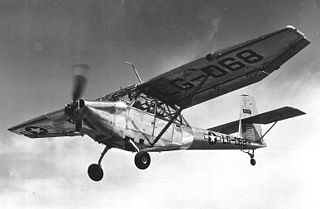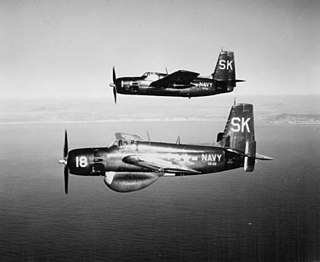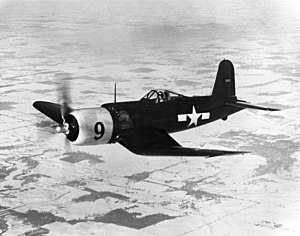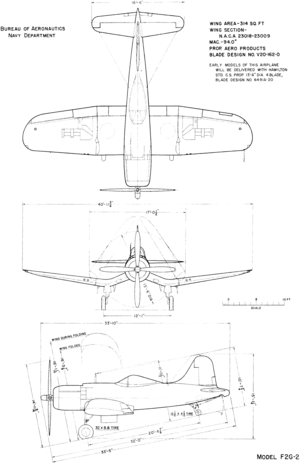
The Vought F4U Corsair is an American fighter aircraft which saw service primarily in World War II and the Korean War. Designed and initially manufactured by Chance Vought, the Corsair was soon in great demand; additional production contracts were given to Goodyear, whose Corsairs were designated FG, and Brewster, designated F3A.

The Pratt & Whitney R-4360 Wasp Major is an American 28-cylinder four-row radial piston aircraft engine designed and built during World War II. First run in 1944, at 4,362.5 cu in (71.5 L), it is the largest-displacement aviation piston engine to be mass-produced in the United States, and at 4,300 hp (3,200 kW) the most powerful. It was the last of the Pratt & Whitney Wasp family, and the culmination of its maker's piston engine technology.

The Douglas XTB2D Skypirate was a torpedo bomber intended for service with the United States Navy's Midway- and Essex-class aircraft carriers; it was too large for earlier decks. Two prototypes were completed, but the dedicated torpedo bomber was becoming an outdated concept, and with the end of World War II, the type was deemed unnecessary and cancelled.

The Grumman C-1 Trader is a carrier onboard delivery (COD) variant of the Grumman S-2 Tracker. It was replaced by a similar version of the Northrop Grumman E-2 Hawkeye, the Grumman C-2 Greyhound.

The Grumman F6F Hellcat is an American carrier-based fighter aircraft of World War II. Designed to replace the earlier F4F Wildcat and to counter the Japanese Mitsubishi A6M Zero, it was the United States Navy's dominant fighter in the second half of the Pacific War. In gaining that role, it prevailed over its faster competitor, the Vought F4U Corsair, which initially had problems with visibility and carrier landings.

The Grumman F7F Tigercat is a heavy fighter aircraft that served with the United States Navy (USN) and United States Marine Corps (USMC) from late in World War II until 1954. It was the first twin-engine fighter to be deployed by the USN. While the Tigercat was delivered too late to see combat in World War II, it saw action as a night fighter and attack aircraft during the Korean War.

The Grumman F8F Bearcat is an American single-engined, carrier-based, fighter aircraft introduced in late World War II. It served during the mid-20th century in the United States Navy, the United States Marine Corps, and the air forces of other nations. It was Grumman Aircraft's last piston-engined fighter aircraft.

The Kawanishi N1K was an Imperial Japanese Navy fighter aircraft, developed in two forms: the N1K Kyōfū, a floatplane designed to support forward offensive operations where no airstrips were available, and the N1K-J Shiden, a land-based version of the N1K. The N1K-J was considered by both its pilots and opponents to be one of the finest land-based fighters flown by the Japanese during World War II.

The Pratt & Whitney R-2800 Double Wasp is an American twin-row, 18-cylinder, air-cooled radial aircraft engine with a displacement of 2,800 cu in (46 L), and is part of the long-lived Wasp family of engines.

The Stinson L-13 was a US military utility aircraft first flown in 1945.

The Polikarpov Po-2 served as an all-weather multirole Soviet biplane, nicknamed Kukuruznik. The reliable, uncomplicated design of the Po-2 made it an ideal trainer aircraft, as well as doubling as a low-cost ground attack, aerial reconnaissance, psychological warfare and liaison aircraft during war, proving to be one of the most versatile light combat types to be built in the Soviet Union. As of 1978 it remained in production for a longer period of time than any other Soviet-era aircraft.

The Lavochkin La-9 was a Soviet fighter aircraft produced shortly after World War II. It was one of the last piston engined fighters to be produced before the widespread adoption of the jet engine.

The Boeing XF8B was a single-engine aircraft developed by Boeing during World War II to provide the United States Navy with a long-range shipboard fighter aircraft. The XF8B was intended for operation against the Japanese home islands from aircraft carriers outside the range of Japanese land-based aircraft. Designed for various roles including interceptor, long-range escort fighter, dive-bomber, and torpedo bomber, the final design embodied a number of innovative features in order to accomplish the various roles. Despite its formidable capabilities, the XF8B-1 never entered series production.

The Republic XP-72 was an American prototype fighter-interceptor developed by Republic Aircraft as a progression of the P-47 Thunderbolt design. The XP-72 was designed around the Pratt & Whitney R-4360 Wasp Major 28-cylinder air-cooled radial engine with a supercharger mounted behind the pilot and driven by an extension shaft from the engine. The armament consisted of six .50 caliber (12.7 mm) wing-mounted Browning AN/M2 machine guns and underwing racks for two 1,000 lb bombs; Alternative armament packages included two 37 mm M4 autocannons with four .50 caliber AN/M2s, or four M4 autocannons.

The Consolidated PB4Y-2 Privateer is an American World War II and Korean War era patrol bomber of the United States Navy derived from the Consolidated B-24 Liberator. The Navy had been using B-24s with only minor modifications as the PB4Y-1 Liberator, and along with maritime patrol Liberators used by RAF Coastal Command this type of patrol plane was proven successful. A fully navalised design was desired, and Consolidated developed a dedicated long-range patrol bomber in 1943, designated PB4Y-2 Privateer. In 1951, the type was redesignated P4Y-2 Privateer. A further designation change occurred in September 1962, when the remaining Navy Privateers were redesignated QP-4B.

The Grumman AF Guardian is the first purpose-built anti-submarine warfare (ASW) carrier-based aircraft to enter service with the United States Navy. It consisted of two airframe variants, one for detection gear, the other for weapons. The Guardian remained in service until August 1955, when it was replaced by the twin-engined Grumman S-2 Tracker. The Guardian was the largest single-engine piston-powered carrier aircraft ever to see service.

The Meyers OTW was a 1930s United States training biplane designed by Allen Meyers and built by his Meyers Aircraft Company from 1936 to 1944.
Cook Cleland was a United States Navy officer, World War II flying ace, and civilian air race pilot. He participated in the Battle of Coral Sea and the Battle of the Philippine Sea. Cleland won the 1947 and 1949 Thompson Trophy Air Races.
The Vought V-326 was an American experimental aircraft used by Pratt & Whitney as a high altitude engine test bed.






















